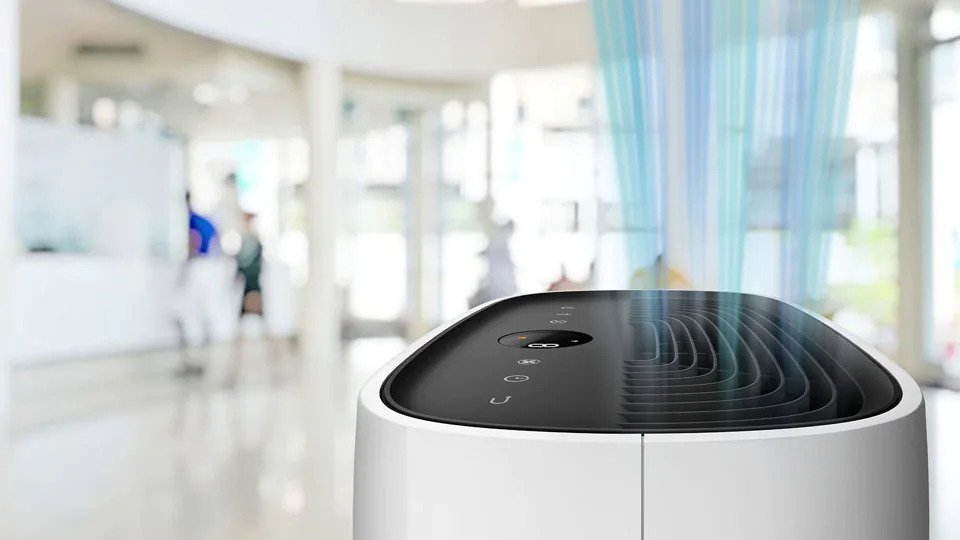
“Why should I buy Philips just because everyone else is buying it” is what I thought to myself before buying our first air purifier. Of course, Philips air purifiers in India are such a class apart that I ended up buying one on that day anyway.
Now, we own two!
If you’re also considering buying an air purifier in India, then we can’t recommend them enough for a wide variety of different reasons. We’ll not only talk about all those reasons in this guide but will also review the best Philips air purifiers in India from the most pocket-friendly to the most advanced.
Here’s everything you’ll find on this page.
If you don’t need any convincing that Philips air purifiers are the best in India then feel free to skip the first few sections by using the clickable navigation panel below.
- How Effective is a Phillips Air Purifier for Home?
- Is an Air Purifier from Phillips a Better Choice than Other Brands?
- Where Should I Place My Philips Purifier?
- How Long Does the Philips Air Purification Technology Last?
- How Can You Clean Your Philips Air Purifier Filter?
- Top 2 Best Philips Room Air Purifiers in India for Small Rooms: Detailed Reviews
- Top 2 Philips Air Purifiers in India for Small Rooms: Detailed Reviews
- Top 2 Best Philips Room Air Purifiers in India for Medium Rooms: Detailed Reviews
- Top 2 Best Philips Room Air Purifiers in India for Large Rooms: Detailed Reviews
How Effective is a Phillips Air Purifier for Home?
In a word? Yes.
Philips is the market leader in India. In other words, it sells the most air purifiers in India.
In fact, even though Philips is a multinational company headquartered in the Netherlands, India is of immense value to them.
You see, the largest portion of their revenue comes from India.


We’re highlighting this fact because it explains a lot. For instance, now that you know how important the Indian market is to Philips, you know why they’re so incredibly committed to it.
India’s importance to Philips and their commitment to their products sold here are interdependent. Their revenues are high because they devote themselves to this market and they devote themselves to this market because they depend on it for their profits.
For you, the air purifier buyer, this is important because it means that the company depends on the Indian market. Therefore, their products are almost custom-made for use in our country.
For instance, if you’ve ever tried to use electronics made for other countries in India, you would’ve noted that when there is a power cut, the device doesn’t start again on its own. You have to manually do it.
This is because power cuts are not common in other countries and auto-restarts are avoided because products can get damaged. However, in India, all electronics are designed for auto-restart after power cuts because there are so many power cuts.
Philips’s dedication to the Indian market also means that the company will never stop supporting its products here.
This ensures excellent post-sales service and availability of spares which is again crucial to us because we like to buy products that can be used for years and decades.
Is an Air Purifier from Phillips a Better Choice than Other Brands?
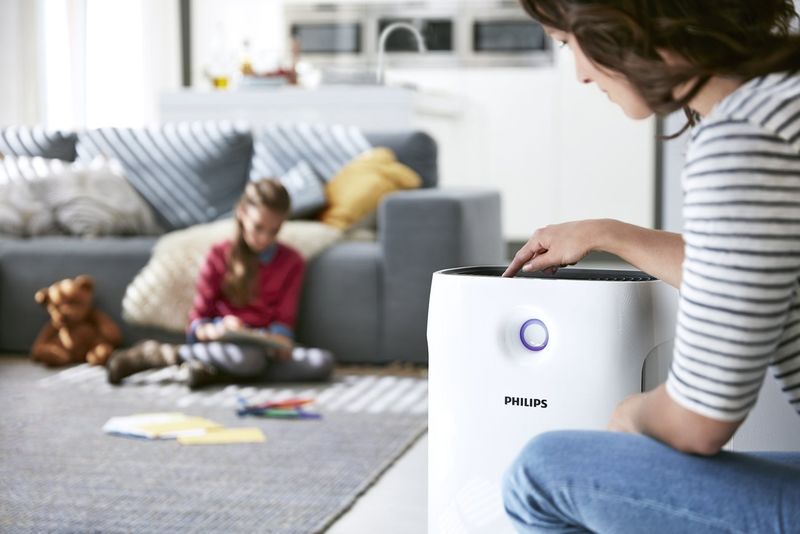

So, now that we know how and why Philips air purifiers are effective in India, the obvious question is “what about other brands of air purifiers”?
The answer depends on what you’re looking for.
In terms of overall performance, no other air purifier brand in the country can compete with Philips. Most importantly, air purifiers from this brand are market leaders because of their filter availability. It doesn’t matter which model you buy or own already, it is super easy to find a filter for a Philips air purifier for home in India.
What other air purifiers can beat Philips air purifiers on are innovation and unique features. For instance, it is only after Mi’s game-changing WIFI-enabled air purifier started taking over the market that Philips decided to launch its own WIFI air purifier in 2020.
We even reviewed this revolutionary device from Mi in our list of top home air purifiers in India.
Similarly, newer competing products have started appearing in the market with unique HEPA filters or additional purification technologies such as Coway air purifiers and Havells air purifiers respectively.
These devices compete well with the best air purifiers in the country. The only risk involved with buying those purifiers is that you cannot be sure of replacement filter availability unless those companies commit to the Indian market.
Therefore, you can buy those devices to get slightly more advanced technology but if replacement filters are not available then you’ll just have a decorative piece at the end of the next one or two years.
There’s another way that Philips air purifiers beat competing products and it’s not because of something that Philips does. After all, the fact that there are multiple aftermarket or third-party suppliers for Philips replacement filters is not something you can credit Philips for.
There are so many aftermarket options because Philips is such a major player in the country.
You can find replacement filters for Philips air purifiers at lower prices in the market simply because of these aftermarket suppliers.
While not at the same level of quality as the original Philips air filters, these aftermarket filters do save you a chunk of money without compromising on quality too much.
Best Philips Air Purifier for Small Rooms | Best Philips Air Purifier for Medium Rooms | Best Philips Air Purifier for Large Rooms |
Philips AC1215/20 Air Purifier | Philips AC2958/63 Air Purifier | Philips AC3059/65 Air Purifier |
The most sold Philips air purifier in India that will save you a lot of money while helping you breathe easy in your bedroom. | The latest WIFI-enabled mid-size air purifier that is excellent for most central rooms in most homes. | An excellent, modern air purifier with the latest features designed for large rooms like living rooms and halls. |
Where Should I Place My Philips Purifier?
This is a universal question. What we mean is that it doesn’t only relate to Philips air purifiers. It applies to all air purifiers.
The answer varies according to the design of the purifier. There are two prevalent designs currently in the market.
The first is the flat rectangular design. These usually have vents in the front and at the top. The front vents are for sucking the polluted air in while the top vent is for throwing out the purified air.
These devices can be safely kept against the wall. However, their location still needs to be somewhere in the middle of the room. If you put them in one corner, then the air in the opposite corner may not get purified fully, unless you have a very small room.
The other, more modern design is the tower. Its vents are located all around its body instead of just in the front. The vents for purified air remain at the top but they’re arranged in a circular format.
The benefit of this design is greater efficiency. The device can take in more air and push out more air which means that it purifies the room more quickly.
Further, the circular filters also don’t have edges like the flat ones do. This along with the more diffused intake of air also prevents dirty air from sneaking around the sides.
The flat air purifiers are designed to be kept against a wall while the round ones are supposed to be kept away from the wall.
This doesn’t mean that you can’t keep the tower air purifiers against the wall, though. It just means that by giving it clearance space all around it, you just make it more effective.
If you do have to place it next to the wall, make sure that you clean around and behind it regularly as dust can build up due to high-pressure suction of air through a small place.
How Long Does the Philips Air Purification Technology Last?
Multiple variables play a role here.
The first is the HEPA filter grade. The higher the grade of the HEPA filter, the higher its surface area will be.
This means that it will last longer.
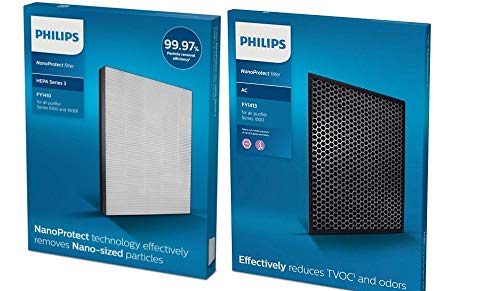

Generally, the following estimates apply.
- H11 and H12 grade filters last about one year.
- H13 grade filters last 18 months.
- H14 grade filters can last upwards of two years.
- Combi filters normally perform somewhere between H13 and H14 grade HEPA filters.
However, it is important to remember that the working environment also plays a role. This means variables like:
- What the AQI is where you live – indoors and outdoors?
- What settings and fan speed you use your air purifier on?
- How often and long you keep your air purifier on?
- How well sealed your home is?
- How often and well you clean your pre-filter?
In the majority of cases, the estimates given by Philips for its devices are conservative. They will want you to change the filter the moment you get the alert.
However, you should see the alert as the beginning of the end of the filter. In other words, you don’t need to replace the filter but should expect your air purifier’s performance to steadily decline from the point that the device alerts you.
This means longer periods of high fan speeds and reduced air purification capability.
If you want to keep your device running at optimal conditions, replace the air filter immediately. If you have more questions, we’ve answered all of them in a separate post on replacement air purifier filters.
How Can You Clean Your Philips Air Purifier Filter?
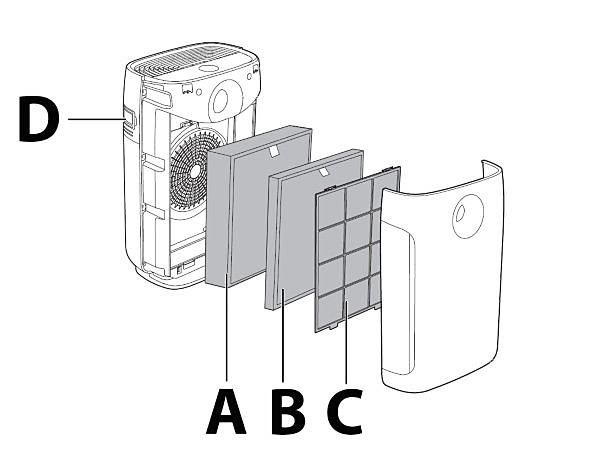

Three things need to be cleaned in an air purifier.
The first is the machine itself and it is probably the easiest. As you use your device, you’ll find dust collecting near the vents.
- Simply use a wet wipe or damp cloth to wipe the surface around the intake and output vents.
- Make sure to open the panel and clean the insides too as dust collects there as well.
- Remember to either air dry the surface you’ve wiped or wipe it with a dry cloth.
You’ll also have to regularly clean the pre-filter.
- To do this, open the panel and take the pre-filter out.
- First, shake and tap all the gathered dust loose.
- Do this either in your bathroom or outside your home. There can be a considerable buildup on the pre-filter that can spread in your home.
- It might be a good idea to wear a mask so as not to inhale this dust.
- Once the pre-filter is tapped out, take it into the bathroom and clean it with water.
- You can use a hand shower, a tap, or dip it in a tub.
- Air-dry the pre-filter before returning it to the air purifier.
The third thing you’ll have to clean will be the sensor of the device. You’ll need to do this once every year or so. You’ll know the sensor is dirty and choked when the AQI indicator of your air purifier constantly stays in red.
This can be a little tricky because it is a small space and you don’t want to damage anything.
- Locate and open the panel protecting the AQI sensor on the device.
- It will be located on the side of the device and the panel will open sideways like a door. Don’t pull it out. It is not like the big panel protecting the filters.
- Once open, use a wet wipe or small, wet rag to clean the insides.
- Since the area is small, we recommend using a pair of tweezers. Wrap your wet wipe around the tip of the tweezers and wipe the insides of the sensor.
- Turn on the air purifier. If the AQI monitor doesn’t stay frozen, you’ve done a good job. If it does, go back to the sensor and clean deeper.
Product Name | CADR | Recommended Room Size | HEPA Filter Grade | Price Bracket | Price |
190 cu m/hr | 234 sq. ft. | H13 | Super Cheap | ||
270 cu m/hr | 333 sq. ft. | H13 | Cheap | ||
333 cu m/hr | 409 sq. ft. | H13 | Affordable | ||
380 cu m/hr | 484.3 sq. ft. | H13 | Affordable | ||
400 cu m/hr | 516 sq. ft. | H13 | Very Expensive | ||
500 cu m/hr | 645 sq. ft. | H13 | Super Expensive |
Top 2 Best Philips Room Air Purifiers in India for Small Rooms: Detailed Reviews
#1: Philips Air Purifier AC0817/20
Editor’s Rating: 6.5/10
This is the cheapest Philips air purifier you can get in India.
As a result, it also happens to be the simplest option available.
While many people often call bigger air purifiers portable, this one is the true portable device because of its super-compact profile.


In fact, it is because of its size that we think it is better suited as an accompaniment to the room air purifier than alone.
For instance, if you have an L-shaped room that your existing air purifier is unable to cope with then you can place this device in the far corner to boost purification efficiency.
Of course, you can also use it in a small room like a cubicle or home office (think as small as servant quarters). For example, you can take it with you to work if your stingy boss refuses to equip the office with an air purifier.
The small size means that this device’s CADR (that’s how much air it throws out every 60 minutes) is as low as 190 m3 per hour. This translates to this device being suitable for a room measuring 160 sq. ft.
The company says that it can handle a room as large as 234 sq. ft. but we find that hard to believe. You can probably manage to use it in a 200 sq. ft. room, though, but only if it is sealed properly.
As to how well it cleans, you cannot compare it to the company’s room air purifiers. Those devices, at least, have an H13 HEPA filter. This one only has an H12 and there’s a huge difference between the two.
You see, H12 grade HEPA filters can only purify up to 99.5% of particulate matter as small as 0.003 microns but H13 grade filters can manage as much as 99.97%.
That’s a difference of 0.47%. It doesn’t seem much but it is considerable as far as this technology goes. For perspective, the higher grade HEPA filters i.e., H14 and H15 are capable of 99.975% and 99.9975%.
Even so, if you have allergies and need a super-portable air purifier, then this device would suffice. It is, after all, certified by the European Centre for Allergy Research Foundation (ECARF).
Another feature of this device that is a result of its compactness is that there’s only one button. You’ll be using this button to choose different modes and perform all other functions of the device.
The available modes are Auto and Sleep. The Auto mode is closely connected to the AQI indicator. The indicator uses colors to show you the state of the air in the room.
The Auto mode uses this information to change the fan speed of the device. Be aware that when this device is operating at the highest fan speeds, it tends to get noisy.
There’s a filter indicator as well that will tell you when they need changing. Unfortunately, the filters are small which means that they need to be changed far more often than you would feel comfortable with.
On the other hand, its small size means that it doesn’t consume a lot of power. It is rated to use about 20W of power which is the same as a light bulb.
For its size, it is a bit expensive. Other similarly sized devices in the market are cheaper. However, the relatively higher price of this Philips air purifier is because it contains a HEPA filter. Most of its competitors don’t.
At the same time, most of its competitors are battery-based, while device one needs to be plugged in to be operational.
Unlike its competitors, though, you’ll get a 2-year worldwide warranty from Philips.
Who’s it for: If you can’t spend too much and need something super-portable, get this portable Philips air purifier.
Tech Specs | Pros | Cons |
|
|
|
#2: Philips AC1217 or AC1215/20 Air Purifier
Editor’s Rating: 9.0/10
Philips Air Purifier AC1217 and AC1215 are very similar devices. The Philips AC1217 is a more recent model and supposedly more advanced. However, this is not evident when you look deeper.
The Philips 1217 air purifier is not only more expensive than the Philips 1215 air purifier but it is also louder and less effective in terms of coverage area or air throwing power (CADR).
At the same time, you need to know that the difference between the AC1217 and AC1215 are so minor as to almost be negligible.
Therefore, if you’re being asked to choose between the two, we recommend the AC1215 but if you can only find the AC1217 then you shouldn’t avoid the purchase.


As it is, the Philips Air Purifier AC1215 is possibly the most purchased and widely used air purifier in India.
It also needs to be credited with giving Philips the air purifier market on a platter. This is the product that is the reason why Philips is a market leader in India.
In terms of all the Phillips air purifier prices in India, this one is likely to suit your specific requirements and restrictions best. In fact, it offers all the core functions of an air purifier at a price that falls sweetly in that financial bracket that is suitable for most middle-income families in the country.
This is why so many people ended up buying this product.
If you weren’t one of those people, then you would now think that this device is criminally simple, especially when compared to all the latest IoT-type offerings. However, when it comes to purifying air, this device does wonderfully well.
It is based on an H13 grade HEPA filter which is extremely efficient. Even though it is less efficient than an H14 grade HEPA filter, the difference is not big enough to merit much discussion.
You’ll often find this device described as a bedroom air purifier because of its size and capacity. It has a CADR of 270 m3 per hour which is just about right for a room measuring 250 sq. ft. With proper seals, you can probably push this to 300 sq. ft.
Philips even specifies that, if put in a room measuring 18 ft. x 12 ft. x 8 ft., this device would be able to purify all the air in less than 12 minutes flat.
Other than the HEPA filter, this air purifier also has a pre-filter and an activated carbon filter. Both do a good job and neither comes off as poor quality.
There are three Auto modes to choose from – General, Allergen, and NightSense. All have different maximum fan speeds with the NightSense being particularly noteworthy.
The NightSense mode is designed to be used at night when you’re sleeping. Turning it on will kill the device’s lights and minimize high fan speeds without compromising on air quality.
Essentially, the device will go into turbo mode for the first 15 minutes before dropping fan speeds really low. If the air quality drops in the night, the fan speeds go up but never to maximum levels because it tries to minimize noise.
Another feature of this mode is that it turns on when the device detects low lighting conditions. The only problem is that it doesn’t turn off properly enough when the room becomes bright.
Other than these modes, there are also four manual fan speeds including Turbo.
The AQI indicator on this device is color-coded ranging from red (bad) to blue (good). Unfortunately, at this price range, a numerical AQI display is not available in any product.
There’s also a filter change indicator and a child lock for convenience of use.
Like all Philips air purifiers, this one is also tested approved by the European Centre for Allergy Research Foundation (ECARF).
Pricing-wise, we’ve already mentioned that it is within the range of most Indians. What we didn’t mention is that this device is cheaper than all its competitors with similar capabilities.
Who’s it for: This cheap Philips air purifier is ideal for middle-class families in India with maximum bang for the buck.
Tech Specs | Pros | Cons |
|
|
|
If this and the previous device don’t exactly meet your needs, there are other super-cheap air purifiers you can go for too.
Top 2 Best Philips Room Air Purifiers in India for Medium Rooms: Detailed Reviews
#1: AC2887 Philips Air Purifier
Editor’s Rating: 8.5/10
The Philips AC2887 air purifier was the most popular such device for medium-sized rooms in India for a long time.
While it wasn’t as popular as Philips’s iconic AC1215/20, it was still hugely successful in the Indian market.
It would have carried on being exceptional too, except Philips launched an improved version that has already started taking over the market.


We’ll be reviewing that product next but first, let’s do this one because it is more affordable than that one.
This device’s success is based on its suitability for the upper-middle-income bracket in the country. This suitability, of course, is a result of its price and its capacity which makes it good for slightly larger rooms.
Depending on the time of year and ongoing deals, you can get this device for anything between ₹15,000 and ₹20,000. In terms of room size recommendations, you’ll find this device to be more than a match for an area of 325 sq. ft.
For example, the company says that this device can purify a room measuring 216 sq. ft. in mere 10 minutes. Technically, this means that it should be able to purify a 325 sq. ft. room in 15 minutes but it does depend on how well-sealed the room is.
It will perform best in smaller rooms but if you seal the room properly, it can even serve you well in a room exceeding 400 sq. ft. All this, of course, is a result of its 333 m3 per hour CADR.
Its purification abilities are also decent because it is based on an H13 HEPA filter, backed by a pre-filter and an active carbon filter. While it lacks an H14 HEPA filter, we don’t think the difference between the two is significant enough.
In addition to its suitability for the upper-middle class of India, the success of this device was also because of its AeraSense monitors that show AQI of the room numerically and color codes.
The AQI monitor is connected to this device’s 3 smart pre-settings which target specific types of air pollutants. These pre-settings of General, Allergen, and Bacteria & Virus are essentially running modes. Depending on the mode you choose, the device will adjust its fan speeds to suit the AQI of the room.
In terms of features, this device was fully loaded for its time. The only feature it didn’t have was the child lock.
In today’s world, though, it lacks a key feature – WIFI and app connectivity – but that is something that Philips has remedied in their latest launch.
Like all Philips air purifiers, this one also comes with a 2-year international warranty.
Who’s it for: If you’re not looking for WIFI connectivity in your medium room air purifier and want everything else, this device will be perfect.
Tech Specs | Pros | Cons |
|
|
|
#2: Philips AC2958 Air Purifier
Editor’s Rating: 9.0/10
Launched in 2020, the Philips AC2958/63 air purifier is quickly becoming a favorite in the country.
In fact, we’ll stick our neck out and say that this is the best Philips air purifier with HEPA filter in the market toda.
The device is an improvement on the AC2887 in more ways than one.


For instance, with this device, Philips has shown its intent to move away from the flat, wall-hugging design to the tower design.
The tower air purifiers are cylindrical.
While the flat air purifiers take in air from vents in the front, tower air purifiers suck in air from all sides. In both designs, the purified air is released from vents at the top.
However, tower air purifiers tend to be considerably more efficient when it comes to purifying the air. They’re not only faster but also don’t have any blind spots as is the case with wall-hugging air purifiers.
Since tower air purifiers can process air faster, they have a higher Clean Air Delivery Rate (CADR) too. A higher CADR also means that the device can handle larger rooms despite a small footprint.
The AC2958/63 has a CADR of 380 and can handle a room as large as 425 sq. ft provided it is sealed properly. If your rooms aren’t sealed properly, buy this device for 375 or 400 sq. ft. Philips claims it is suitable for 484.3 sq. ft. but that is in lab-like conditions and hard to get in real life.
Another way that this device improves upon the previously famous model is its WIFI compatibility. Newer products from other brands were eating into the Philips market share precisely because of this feature.
However, the AC2958/63 can not only be connected to Philips’s smart app but is also compatible with Google Voice Assistant and Amazon Alexa. You’ll be able to change all settings and access various features with the app.
As to the rest of the device, nothing is off except for one minor issue. This is the fact that this device uses an H13 grade HEPA filter instead of the latest H14.
We think this is a minor issue because H14 doesn’t offer a significant improvement over the H13. The usual pre-filter and activated carbon filter are present too in the combi filter configuration, of course.
Unfortunately, because this device uses a combi filter, aftermarket replacement options for the same are not easily available. This means that you would spend more every time you have to replace the filter but that is the price you pay for cutting-edge technology.
At the same time, the combi filter will have a longer life span too. Philips says that it can last for as long as 3 years but that depends on your usage and how polluted your city is. If it is like Delhi NCR, expect a life of around 2 years but if it is a cleaner city then you can overshoot the 3-year estimate too.
In terms of using it, this device boasts of all the standard features. It has 4 modes – Auto, Sleep, Gentle, and Turbo. The Auto mode takes its cue from the incredibly accurate AQI monitor. The monitor will show you its findings numerically and via colors where red is extremely unhealthy while blue is purified.
This device also has a smart filter status indicator. This indicator evaluates and displays how much pollution the device has processed.
Being the newest and most advanced air purifier in the market, you shouldn’t be surprised that of all the Philips air purifiers, the price of this one is at the upper end. It is costly to buy but since its filters last a long time, it isn’t expensive to run.
Philips is also very good at supporting its customers. Like all their air purifiers, this one comes with a 2-year worldwide warranty.
Who’s it for: If you’re looking for the latest technology in the air purifier market for your medium-sized room and don’t mind paying for it, get this one.
Tech Specs | Pros | Cons |
|
|
|
As with the budget devices, there are affordable air purifiers from other brands that you can try too if you wish to avoid Philips.
Top 2 Best Philips Room Air Purifiers in India for Large Rooms: Detailed Reviews
#1: Philips AC3059/65 Air Purifier
Editor’s Rating: 8.5/10
The Philips AC3059/68 air purifier is very similar to the AC2958/63 in terms of all its features. The only difference is that this device is meant for much larger rooms.
It has a CADR of 400 m3 per hour which means that it can comfortably handle a room with an area of 475 sq. ft. provided it is sealed properly.
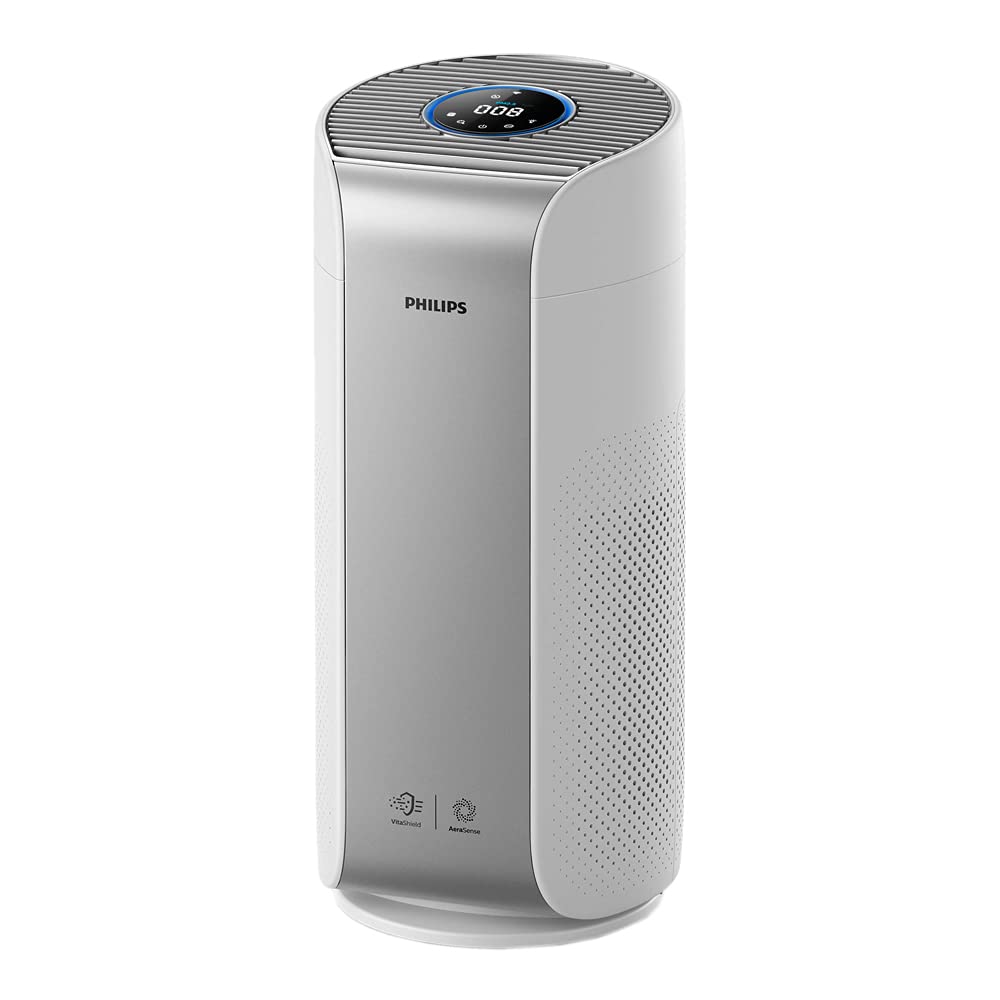

In lab-like conditions, it can manage 516 sq. ft. but if your room is leaky then it may not even be able to cope with 450 sq. ft.
The rest of this device is virtually identical to the one we reviewed earlier. For instance, like that one, this one is also based on an H13 HEPA filter within the combi filter configuration. The combi filter also incorporates a 3-layer pre-filter and an activated carbon filter.
Similarly, this device is WIFI enabled which means that you can use it with Philips’ smart app. It is also compatible with Google Voice Assistant and Amazon Alexa.
It has 4 modes which are Auto, Sleep, Gentle, and Turbo. The AQI sensor is very accurate and shows findings numerically and through colors.
Further, it has the smart filter status indicator that tracks and shows how much pollution the filters have already processed. This indicator will also tell you when to change the filters.
One key difference, however, is that Philips recommends changing filters every 2 years with this device while for the smaller one Philips said 3 years.
Remember, because of its combi filter configuration, you’re not likely to find aftermarket replacement options.
Like all air purifiers for larger rooms with state-of-the-art features and technology, this device is also priced expensively. The good bit, though, is that it is fairly reliable and backed by a 2-year worldwide warranty.
Who’s it for: If you want a state-of-the-art and reliable air purifier for your large living room or hall, go for this one.
Tech Specs | Pros | Cons |
|
|
|
#2: Philips AC5659/20 Air Purifier
Editor’s Rating: 7.5/10
This is the largest device on Philips’s roster. It is intended for huge rooms of almost industrial proportions.
It has a CADR of 500 m3 per hour which translates to 645 sq. ft. in lab-like conditions.
Even in real-world conditions, though, this air purifier is a beast.
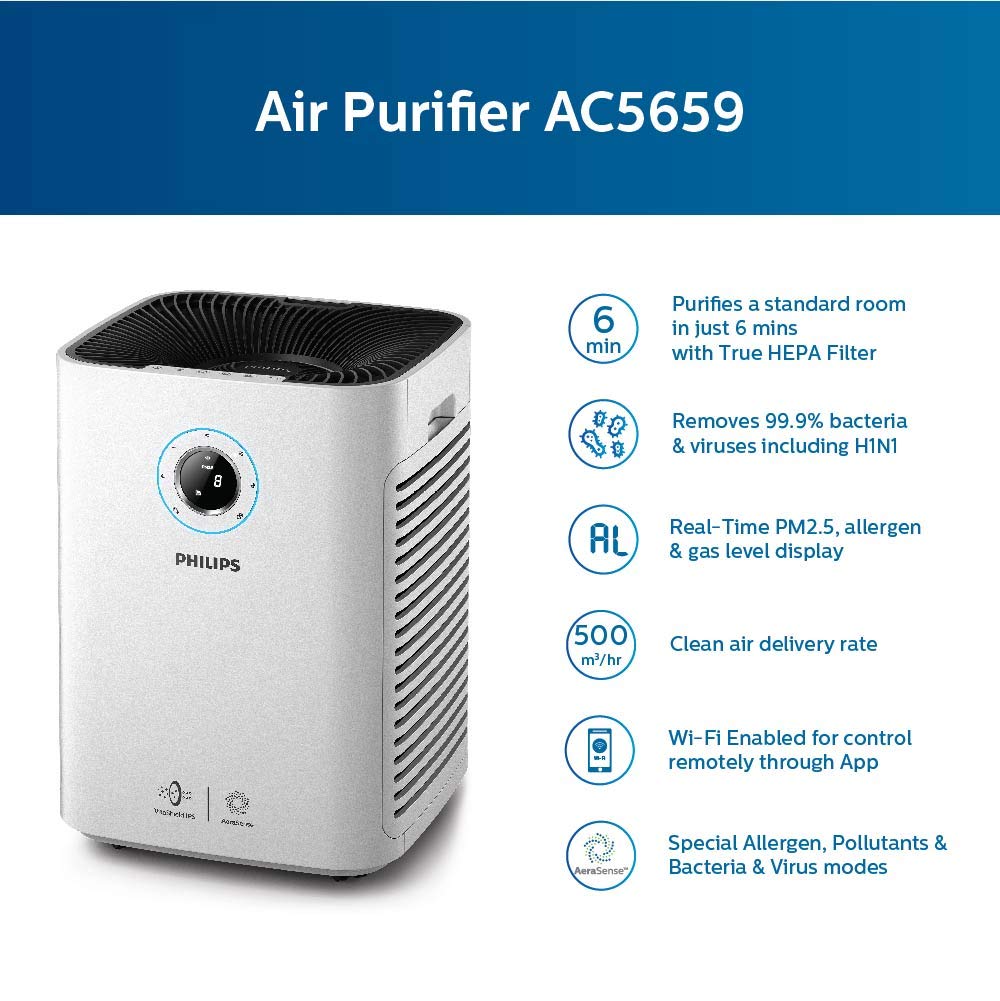

You can expect it to hold its own in rooms as large as 600 sq. ft. if they’ve been sealed properly. It should be able to handle unsealed rooms measuring 550 sq. ft. with ease.
It has a squarish tower design that boasts of “unique dual airflow”, as per the company. This dual airflow design does boost the CADR of the device but it isn’t as unique as the company says. Other air purifier brands are claiming the same thing.
There are other features that hint at this device’s semi-industrial personality. For example, it boasts of separate monitors for indoor air allergen, harmful gases, and PM 2.5.
The allergen indicator will show values ranging from 1 to 12 while the harmful gases will be shown on a scale of L1 to L4. The PM2.5 levels are shown numerically too. Additionally, the device’s display shows air quality by changing color.
The monitors are very accurate with the indicators showing values numerically and in color codes.
The combi filter inside this device is based on an H13 grade HEPA filter and includes a pre-filter and a carbon filter.
It is also approved to be allergy-friendly by the European Center for Allergy Research Foundation (ECARF) and tested by Airmid for its capability against the H1N1 virus. Incidentally, if you didn’t know, coronavirus is considered to be similar to H1N1 in size.
There are 3 modes to choose from. These are General, Bacteria & Virus, and Allergen. All the features and modes of this device can be accessed through the Philips app once the device has been connected to the WIFI.
All these features, and especially its size, mean that this device is super expensive. However, it does allow you to purify a huge hall that would otherwise need two separate devices.
The biggest challenge with this device, though, isn’t its cost. It is the availability of its replacement filter. It’s not easily available even with the company and you can forget about aftermarket options.
Who’s it for: If you need to purify the air in a huge room and don’t want the hassle of managing multiple devices, get this beast air purifier.
Tech Specs | Pros | Cons |
|
|
|
If you’re willing to spend so much on these devices, you should definitely consider Dyson air purifiers.
Contents






